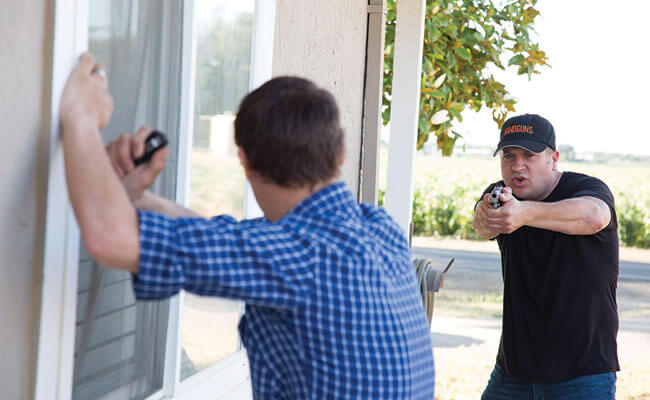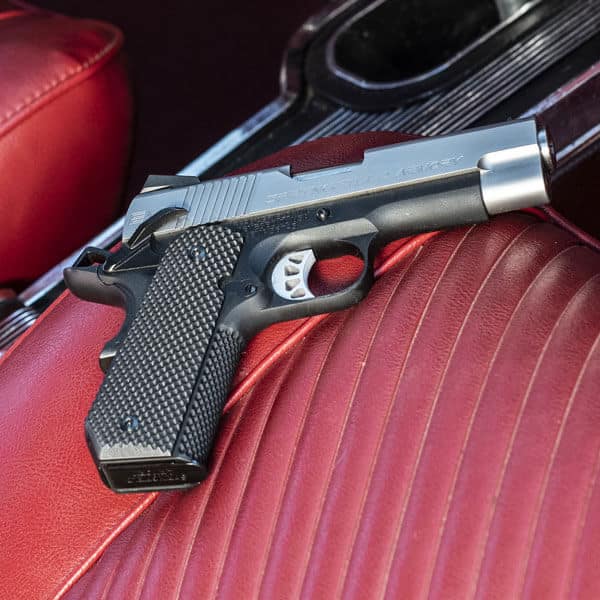Verbal Skills During An Armed Encounter
July 3rd, 2019
4 minute read
Managing an armed encounter successfully takes more than shooting skills. Put yourself in a better defensive position with these essential verbal skills.
Verbal Strategy
Verbal skills tend to come in handy during an armed encounter. As a police officer, I’ve used the “gift of gab” to great effect on a number of occasions, but verbal skills aren’t just for cops. Saying the right thing at the right time—and with the right delivery—can prompt a would-be assailant to back down. Since voluntary compliance is always preferred to bloodshed, it’s important to give careful consideration to how you can communicate effectively in crisis.
The problem with many well-intended firearms instructors is they offer to their students little more than a few canned phrases such as “Don’t move!” “Drop the weapon!” or “I have a gun! If you come through the door, you will be shot!” While any of these directives could prompt a criminal to reconsider his plan, they could also backfire.

Rather than rely on these phrases, students of the gun must be trained to think before they speak. Let’s say you turn away from the ATM and are confronted by a thug who sticks a gun in your face. Clearly, you’re in no position to issue verbal commands, but the right words and tone could still be of tremendous benefit.
Saying something like this might work well. “Hey, buddy. Calm down. I’ll do whatever you say. Take my wallet, just please don’t hurt me.” This type of submissive verbal response is an excellent segue to you either cooperating or feinting cooperation until it’s more advantageous to counterattack.
Another good strategy when an assailant has the drop on you is to ask questions. While pretending to beg (or actually begging) for your life, ask what the assailant wants you to do. When you ask a question, the assailant will likely consider what you’re asking, and this will likely make him just a bit hesitant.
If you’re planning to counterattack, the time to make your move is when the assailant starts to answer. That’s because it’s hard to talk and shoot at the same time—which is a good thing to keep in mind when you are armed and giving verbal commands.
Body Language
Make sure your body language matches your spoken language. Your tucked chin and raised open hands appear to match your submissive speech, but this posturing actually prepares you to act, if that’s what you choose to do. Your chin down minimizes the likelihood of being knocked out if you are struck in the head, and your hands being up enables you to more efficiently fend or redirect and control the weapon.
So should you give verbal commands if you’re in a position to do so? There’s no right answer. If you catch a burglar attempting to pry open a window screen on your house with a knife, bellowing out clear, unconditional directives like those previously mentioned would make sense—especially if those orders were issued from behind cover. They would likely cause most criminals to either comply or flee.
Now, imagine walking around the corner of a building and seeing an assailant holding someone hostage with a weapon. Should you issue a forceful verbal command? If you’re thinking, you realize that by verbally challenging the assailant in this scenario, you may make an already highly volatile situation even worse.
At the very least, you will have forfeited the element of surprise and put the ball in the assailant’s court. Will he run away? Attack the person he was threatening? Attack you? If you’ve just barked orders at him, you’re about to find out.
Warning Obligations
As the good guy, are you obligated to give an assailant warning prior to using deadly force? Not necessarily. While such a warning may be required in some states, many statues are written so that a warning should be given prior to the use of deadly force “when feasible.”
Laws differ from state to state but typically deadly force is authorized to prevent the imminent threat of death or serious bodily injury to yourself or someone else. When an assailant is pointing a gun at someone’s head, that criteria has certainly been met.
What about when someone shatters a window and you and your family move to your “safe room” where you barricade behind the locked door, arm yourself and call 911. Shouldn’t you shout verbal commands from inside the room to advise the intruder that you’re armed and that the police have been called? Not necessarily.
Giving a verbal command alerts the intruder to your location. Then, assuming he enters the room, he has an idea where you are. Heck, he may even shoot through the wall toward the sound of your voice.
Perhaps a more tactically sound plan would be to turn off the lights, get behind cover and watch the door. Should it fly open, you will have a clear view of the intruder because he must come through the doorway to get into the room.
In personal and home-defense situations, verbal skills can be important. But don’t assume yelling forceful commands is always the answer. Sometimes it’s better to speak softly or not at all. It’s up to you to gauge the situation and respond appropriately. You’ve got to think before you speak.
Originally appeared in Handguns Magazine.
Join the Discussion
Continue Reading
Did you enjoy this article?

 83
83






